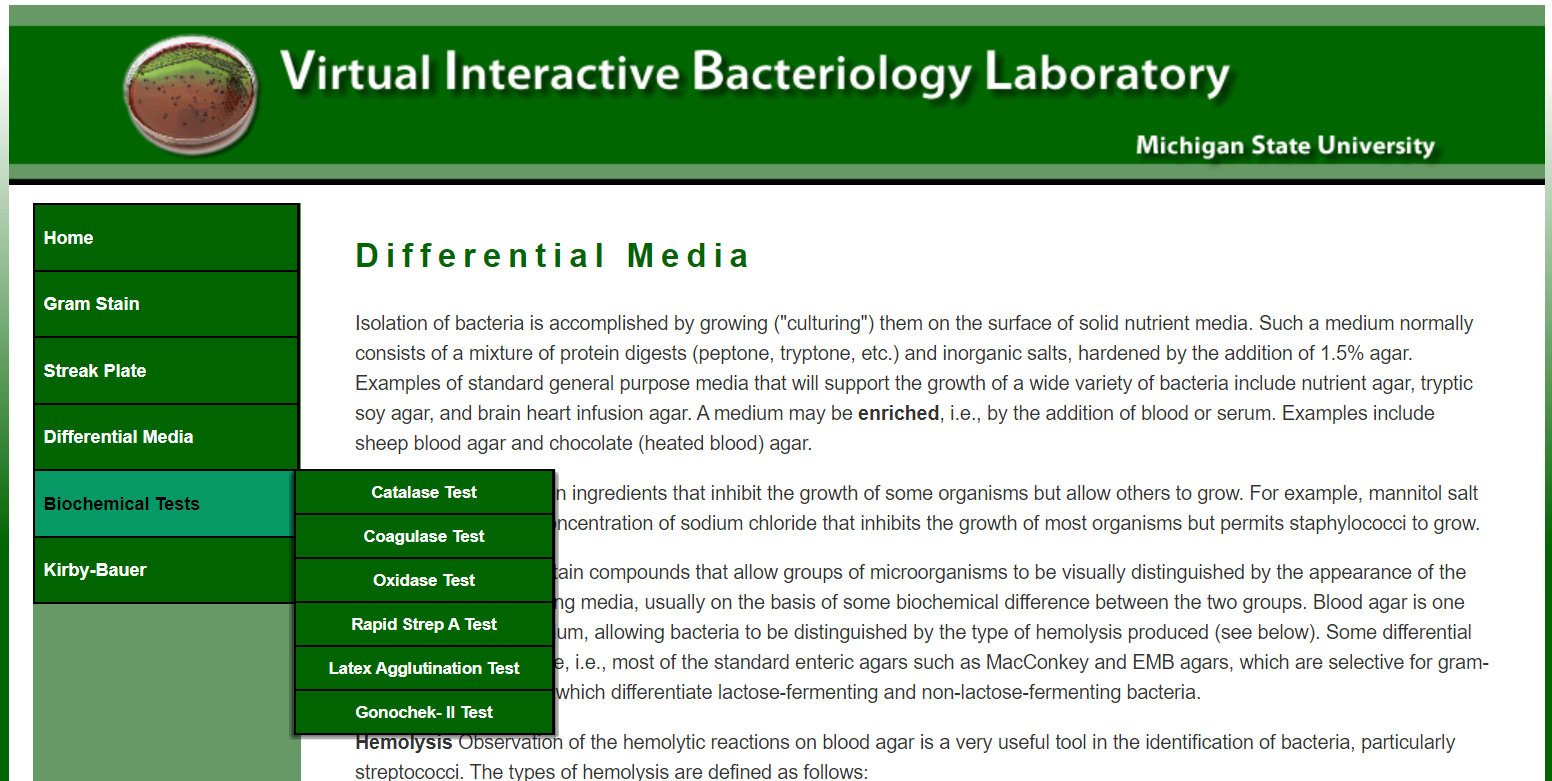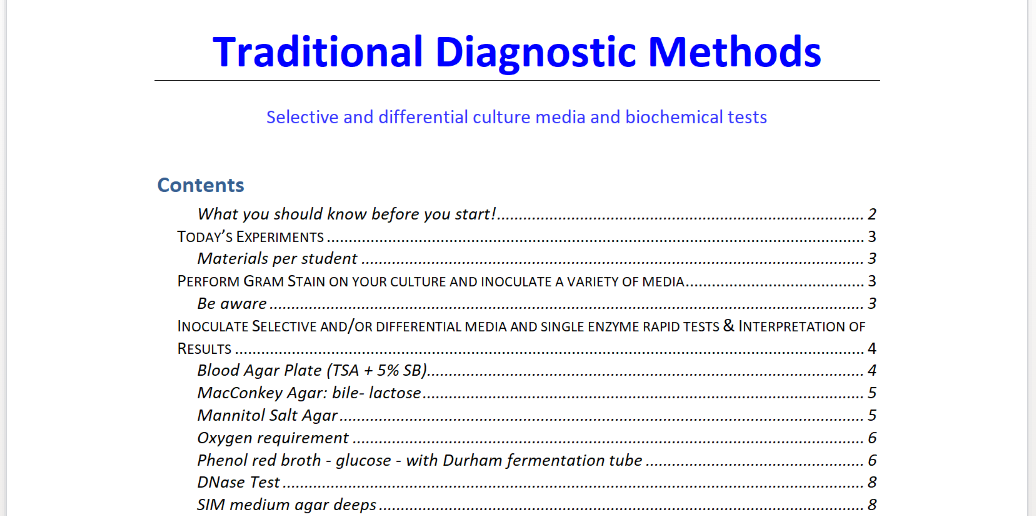Modules – Skills & Tools
Traditional Diagnostics & GIDEON
Background Information
WHY YOU SHOULD CARE ABOUT…
Identifying which organism exactly causes the disease of a patient, is found in a contaminated food sample, or causes plants to die is important for a myriad of reasons. Knowing the identity of a pathogen lets you determine the best method of treat
ment, chose specific treatment methods and lets you study and evaluate novel approaches to combat the organism. Often you just even want to know what type or what specific organisms are in a given sample, like looking for Bifidobacteria in yogurt, or brain eating amoebae (Naegleria fowleri, Balamuthia mandrillaris, Acanthamoeba spp) in Lake Alice. Knowing how to identify a microbe is an essential skill of any microbiologist.
Diagnosing infectious diseases is a challenge but essential to provide the correct care and treatment for human, animal and plant pathogens. We provide you with an interactive, cutting-edge, professional online informatics tool as innovative teaching tool: The Global Infectious Diseases and Epidemiology Network (GIDEON). I am sure you will enjoy exploring this incredible resource and use it to understand identifying infectious disease and diagnosing sick patients.
Access OpenStax: 8.3 Cellular Respiration, 9.2 Oxygen Requirements for Microbial Growth, and 9.6 Media Used for Bacterial Growth
Learning Objectives:
After completing this module, students will be able to:
- Recall new vocabulary and definitions that pertain to this module.
- Use appropriate methods to identify microorganisms (media-based, biochemical and enzymatic tests).
- Demonstrate how to identify a microorganism using GIDEON.
- Recall how traditional diagnostic methods are used in the diagnostics lab and food testing industry.
- Compare and contrast traditional and molecular diagnostic techniques.
- Examine your own microbe (AAM) to see how it reacts on the different media and biochemical tests
History Connections
The story of GIDEON written by GIDEON founders Dr. Steve Berger and Uri Blackman

GIDEON is an acronym for “Global Infectious Disease and Epidemiology Online Network” The initial project was inspired by advanced training in Operational Methods undertaken by Dr. Steve Berger under the auspices of the World Health Organization. In 1993, Dr. Berger and co-founder Uri Blackman released a first version of GIDEON, written in DOS and supplied on floppy discs. The initial version was designed primarily for diagnosis-support based on signs and symptoms. Over the succeeding 25 years. Gideon evolved into a cutting-edge, on-line tool. The current version follows the entire field of Infectious Diseases, with over 3 million words of text, 35,000 graphs, 357 maps, 32,000 graphs, 4,200 images and 216,000 linked references.
GIDEON (Global Infectious Disease and Epidemiology Online Network) is an interactive Web-based program that follows the entire field of Infectious Diseases. GIDEON is an eclectic program that can serve the needs of clinicians, epidemiologists, and microbiologists working in the fields of infectious diseases and geographic medicine.
GIDEON contains
- 350 infectious diseases from around the world
- 200 symptoms, signs, and laboratory data
- 21,000 country-specific notes and pre-travel information, including over 35,000 outbreaks
- 300 antimicrobial drugs with over 29,000 trade names
- Information and books about vaccines, outbreaks and lots of actual data pertaining to outbreaks, occurrences etc.
and was originally designed in 1992 for the healthcare field, doctors, nurses, and clinical laboratory workers. It is updated daily and the numbers are probably outdated already.
Use GIDEON to diagnose, treat and track information on infectious diseases from around the globe.
- Generate a country-specific diagnosis based on symptoms, signs, and laboratory data.
- Display the epidemiological profile of a selected disease and list diseases that fit a set of epidemiological parameters.
- Review country-specific notes and pre-travel information for travelers and medical practitioners
- Review the pharmacology and compare usage of anti-infective drugs
- Review the pharmacology and usage of vaccines
Identify and Track the Underlying Causes of Infectious Diseases
- Identify over 1,600 taxa based on phenotypic characteristics
- View a list of the typical positive and negative reactions for a specified organism
- Compare the reactions of two or more species
- Access comprehensive bacteria, mycobacteria, and yeasts lists as well as over 3,000 synonyms
eBooks by GIDEON
GIDEON eBooks are an encyclopedia of infectious diseases across all countries, worldwide. The entire series is continually updated and represents the only texts of their kind. They complement the excellent GIDEON online diagnostic tool and are a great addition to a library for those practicing infectious diseases, public health, global health, and even primary care. this will be useful for your public health projects as well as your research projects
Using GIDEON as a tool for Microbiology Labs
When working in a lab, sometimes you need to be able to quickly identify different bacteria. Extracting DNA, PCR and sequencing can take days. All of the sequencing data requires advanced bioinformatics that take additional time. Culturing your bacteria using diagnostic media can give you many clues as to the type of species or strain you may have.
CASE STUDY
For a case study you will be immersing yourself in the “GIDEON diagnostic game” where you will form teams and assume the role of either 1. the patient, 2, a physician, 3. a diagnostic lab director, 4. the CDC director or possibly a science journalist or health advocate. After you know a few more tricks and tools how to diagnose a patient with traditional methods, molecular methods and immunological methods you can come back to tackle a real life problem.
Virtual Lab Simulations
Biochemical Tests Simulation:
Online Lab
ACTIVITY #1: Perform traditional diagnostics and enzymatic tests on your microbial organisms
Now it’s your turn to use your organisms.
The GIDEON worksheet can be found here.
Lab Kit Content for this Activity:
- Gloves
- Microbe Set
- B. subtilis
- E. coli
- M. Luteus
- Blood Agar Plate
- MacConkey Plate (MAC)
- Mannitol Salt Plate (MSA)
- DNAse Plate
- Phenol Red Broth-screw cap
- SIM
- Oxidase – dropper
- Catalase (H2O2) – dropper
- Indole dropper
- Tests and Media we use and how these the traditional diagnostic tests are performed:
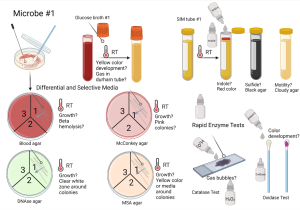
- Inoculate your media
- SIM: https://vimeo.com/73671768
- Phenol Red Broth: https://vimeo.com/73671112
- Blood Agar: https://vimeo.com/73656591
- Mannitol Salt Agar: https://vimeo.com/73668944
- MacConkey Agar: https://vimeo.com/73668126
- DNAse Agar: https://vimeo.com/73662034
- Catalase Test: https://vimeo.com/73659734
ACTIVITY #2: Online simulation of Differential Media and Biochemical Test
Practice 1. Differential Media and 2. Biochemical Tests online at the Virtual Interactive Bacteriology Laboratory
Screenshot and authenticate your activities and add to your ELN.
ACTIVITY #3: Who Am I? GIDEON practice
Explore GIDEON and the GIDEON worksheet and enter your results for your organisms
After your get your results from Activity #1, continue with the GIDEON worksheet to enter your results for the following tests
Differential and selective media
- Blood agar plate (Growth)
- Blood agar plate (Beta hemolysis)
- MacConkey plate (Growth)
- MacConkey plate (Lactose fermentation)
- Phenol red broth – (Glucose fermentation)
- Phenol red broth – (+/- gas from glucose)
- SIM (Sulfite Indole Motility) (H2S production)
- MSA plate (growth in 6.5% NaCl)
- MSA plate (Mannitol fermentation)
Other characteristics and enzymatic tests/reactivity
- Gram reaction, Cell shape and arrangement
- Oxygen requirement: growth in anaerobe chamber
- Oxidase test (add oxidase reagent)
- Catalase test (add H2O2)
- SIM (Motility)
- DNAse plate (DNAse production, halo)
- SIM (Indole production) (add Kovac’s reagent)
- Yellow Pigment (Colony morphology)
Video on how you use GIDEON for traditional diagnostics
Example GIDEON diagnostics – traditional methods – practice: “Who am I?”
To practice entering results try these sample organisms and see what results you get.
Go to GIDEON -> Lab -> Bacteria -> Probability Engine
Who am I? Interpret the results and add it to the probability engine
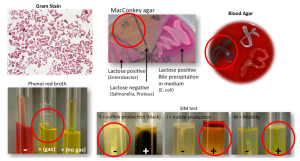
- Oxidase +
- Catalase +
Let’s interpret this one together:
- Gram – rod
- Grows on blood agar (no beta hemolysis)
- Grows on McConkey agar – lactose negative
- Glucose fermentation (phenol red broth) – gas from glucose
- SIM: motile and indole positive, no hydrogen sulfide production
- Oxidase and catalase +

Compare the top 2 results and see what test you can use to distinguish the most likely organism:
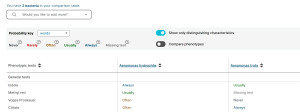
Discuss the following:
- what do you think the microbe may be?
- what disease or illness does it cause?
- what are your thoughts on lab diagnostics and using GIDEON?
Now try to identify other pathogens:
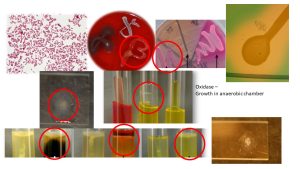
ACTIVITY #4: AAM Traditional Diagnostics
Update your AAM findings!
In-Person Lab
Activity: Traditional Diagnostics
Resources
Take a look at the appropriate module for the vocabulary that is being tested: Microbiology @ UF Lab Terminology Quizlet.
- Check the DIFCO/BBL manual for the composition of the different media and to understand why and how they are selective or differential
- Biochemical Pathways (Roche) interactive
- Merck Manual – Introduction to Laboratory Diagnosis of Infectious Disease

